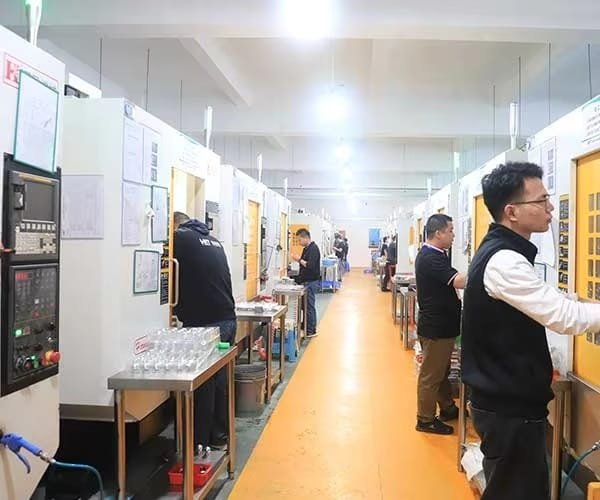Master milling stainless steel with optimal speeds and feeds. Complete guide covering cutting parameters, tool selection, coolant strategies, and troubleshooting for precision machining results.

Milling stainless steel presents unique challenges that require precise understanding of cutting parameters, tool selection, and machining strategies. Unlike conventional steels, stainless steel’s work-hardening characteristics, thermal properties, and chemical composition demand specialized approaches to achieve optimal results. This comprehensive guide explores every aspect of machining austenitic stainless steel milling, from fundamental speed and feed calculations to advanced troubleshooting techniques.
Understanding Stainless Steel Properties for Machining
Stainless steel’s distinctive properties significantly impact machining operations. The high chromium content creates a passive oxide layer that provides both corrosion and heat resistance but also increases cutting forces. Additionally, stainless steel exhibits lower thermal conductivity compared to carbon steel, causing heat buildup at the cutting edge. The austenitic structure in common grades like 304 and 316 tends to work-harden rapidly under mechanical stress, making proper speed and feed selection critical for successful machining.
Essential Speed and Feed Fundamentals

Speed and feed calculations form the foundation of successful stainless steel milling. Surface speed, measured in surface feet per minute (SFM), should fall within the recommended range to determine the cutting velocity at the tool’s periphery. Feed rate, expressed in inches per minute (IPM) or millimeters per minute, controls material removal rate and surface finish quality. The relationship between these parameters directly affects tool life, part quality, and machining efficiency.
Calculating Optimal Cutting Speed for Stainless Steel

Cutting speed calculation begins with determining the appropriate surface speed for the specific stainless steel grade and cutting tool material. For cemented carbide tools on austenitic stainless steel, typical surface speeds range from 200-400 SFM, while high-speed steel tools operate at 50-150 SFM. The formula RPM = (SFM × 3.82) ÷ Tool Diameter provides the spindle speed. Material hardness, tool coating, and machine rigidity influence the final speed selection within these ranges.
Feed Rate Optimization Strategies

Feed rate optimization balances productivity with tool life and surface finish requirements. The chip load per tooth, calculated by dividing feed rate by the product of RPM and number of teeth, should maintain consistent values for different cutting conditions. Insufficient feed rates cause rubbing and premature tool wear, while excessive rates lead to tool chatter, poor finish, and potential tool breakage. Optimal chip loads for stainless steel typically range from 0.002-0.010 inches per tooth, depending on tool geometry and cutting conditions.
Depth of Cut Considerations
Axial and radial depth of cut significantly impact cutting forces and heat generation in stainless steel milling. Shallow cuts may cause work hardening due to insufficient chip formation, while excessive depths create excessive heat and deflection. Axial depths should generally not exceed 50% of the tool diameter for finishing operations, while avoiding excessive vibration, roughing cuts may utilize up to 100% of the flute length. Radial engagement typically performs best at 10-40% of tool diameter for optimal chip evacuation and heat dissipation.
Tool Material Selection for Stainless Steel

Using the right tool, carbide tools offer superior performance for most stainless steel milling applications due to their hot hardness and wear resistance. Uncoated carbide provides excellent chemical stability, while TiAlN and AlCrN coatings enhance performance at higher cutting speeds. High-speed steel tools remain viable for lower-speed operations and complex geometries. Ceramic and cermet tools excel in high-speed finishing applications but require stable machine setups and consistent cutting conditions.
End Mill Geometry and Design Features
End mill geometry profoundly affects stainless steel machining performance. Sharp cutting edges reduce cutting forces and heat generation, while positive rake angles improve chip formation. Variable helix angles minimize chatter, and unequal spacing reduces harmonic vibrations. Selecting sharp edges for corner radius balances strength with surface finish requirements. Specialized stainless steel end mills feature optimized geometries, including polished flutes for improved chip evacuation and reduced galling tendencies.
Coolant Selection and Application Methods

Effective coolant application is crucial for successful stainless steel milling. Flood coolant provides excellent heat removal and chip evacuation, while high-pressure coolant systems enhance performance in deep cavity milling. Minimum quantity lubrication (MQL) offers environmental benefits and improved surface finish in appropriate applications. Coolant selection should consider stainless steel’s tendency to work-harden and the need for consistent temperature control throughout the cutting process.
Work Hardening Prevention Techniques
Work hardening represents one of the primary challenges in stainless steel machining. Maintaining consistent feed rates prevents the cutting tool from dwelling in one location and creating hardened layers. Climb milling typically produces better results than conventional milling by ensuring clean tool entry and exit. Sharp tools and proper speeds minimize the tendency for work hardening, especially when machining surgical instruments while avoiding interrupted cuts in previously machined areas prevents cutting through hardened surfaces.
Machining Different Stainless Steel Grades
Various stainless steel grades require specific machining approaches. Austenitic grades (300 series) work-harden readily and benefit from higher feed rates and positive rake angles. Ferritic grades (400 series) machine more easily but may require different speed selections. Martensitic stainless steels present challenges due to their hardness and may necessitate reduced speeds and specialized tooling. Duplex and super duplex grades combine characteristics of austenitic and ferritic structures, requiring balanced approaches.
Troubleshooting Common Milling Problems
Common stainless steel milling problems include built-up edge formation, excessive tool wear, poor surface finish, and dimensional inaccuracy. Built-up edge typically results from insufficient cutting speed or improper coolant application. Excessive flank wear indicates incorrect speed-feed combinations or inadequate tool coatings. Poor surface finish may stem from chatter, work hardening, or incorrect tool geometry. Systematic troubleshooting approaches help identify root causes and implement effective solutions.
Advanced Machining Strategies

High-efficiency milling (HEM) techniques can significantly improve stainless steel machining productivity. Trochoidal milling paths maintain consistent tool engagement while maximizing material removal rates. Dynamic tool path strategies adapt cutting parameters based on instantaneous cutting conditions. Adaptive machining systems monitor cutting forces and automatically adjust parameters to maintain optimal conditions throughout the operation.
Tool Life Optimization Methods
Maximizing tool life in stainless steel milling requires attention to multiple factors. Proper tool selection, optimal cutting parameters, effective coolant application, and appropriate tool paths all contribute to extended tool life. Regular tool condition monitoring helps identify wear patterns and optimize replacement intervals. Reconditioning programs can restore tool performance and reduce overall tooling costs in high-volume production environments.
Surface Finish Enhancement Techniques
Achieving superior surface finishes in stainless steel during drilling requires careful attention to cutting parameters and tool condition. Higher surface speeds generally improve finish quality, while maintaining appropriate feed rates prevents surface tearing. Tool sharpness and proper geometry selection are critical for achieving mirror-like finishes. Finishing passes with reduced depths of cut and optimized parameters can significantly enhance surface quality.
Productivity Improvement Strategies
Productivity enhancement in stainless steel milling involves optimizing the entire machining process. High-feed milling techniques for aluminum increase material removal rates while maintaining surface quality. Multi-axis machining capabilities reduce setup times and improve part accuracy. Automated tool changing systems minimize non-cutting time, while process monitoring systems ensure consistent quality throughout production runs.
Fixture Design and Workholding Solutions
Proper workholding is essential for successful stainless steel milling operations. Ensuring a stable machine bed, rigid fixtures minimize vibration and chatter while ensuring dimensional accuracy. Adequate clamping force prevents part movement without causing distortion. Fixture design should accommodate thermal expansion and provide adequate access for coolant application. Modular fixturing systems offer flexibility for varying part geometries and production requirements.
Quality Control and Inspection Techniques
Quality control in stainless steel milling encompasses dimensional accuracy, surface finish, and metallurgical properties. Coordinate measuring machines provide precise dimensional verification, while surface roughness meters quantify finish quality. Non-destructive testing methods can verify internal integrity without damaging parts. Statistical process control techniques help maintain consistent quality and identify process variations before they affect part quality.
Cost Optimization in Stainless Steel Milling
Effective cost optimization involves balancing tooling costs, cycle times, and quality requirements. While premium tooling may have higher initial costs, extended tool life and improved productivity often justify the investment. Optimal cutting parameters maximize material removal rates while maintaining acceptable tool life. Proper coolant management reduces both tooling and operational costs while improving part quality.
Safety Considerations and Best Practices
Safety in stainless steel milling operations requires attention to multiple hazards. Sharp metal chips can cause serious injuries and require proper chip management systems. Coolant systems need regular maintenance to prevent bacterial growth and skin irritation. Personal protective equipment, including safety glasses and cut-resistant gloves, is essential. Proper machine guarding and emergency stop systems protect operators from mechanical hazards.
Environmental and Sustainability Factors
Environmental considerations in stainless steel milling include coolant disposal, chip recycling, and energy consumption. Biodegradable coolants reduce environmental impact while maintaining machining performance. Chip recycling programs recover valuable stainless steel scrap for reprocessing. Energy-efficient machining strategies reduce power consumption while maintaining productivity. Minimum quantity lubrication systems reduce coolant usage and disposal requirements.
Future Trends in Stainless Steel Machining
Emerging technologies are revolutionizing stainless steel milling operations. Artificial intelligence and machine learning systems optimize cutting parameters in real-time based on sensor feedback. Advanced tool coatings and substrate materials extend tool life and enable higher cutting speeds. Additive manufacturing techniques create complex tooling geometries previously impossible with conventional manufacturing methods. Industry 4.0 integration connects machining operations with enterprise systems for improved planning and control.
Equipment Selection and Machine Requirements
Proper machine selection is crucial for successful stainless steel milling operations. High spindle power and torque capabilities handle the increased cutting forces associated with stainless steel. Rigid machine construction minimizes deflection and chatter. Advanced control systems provide precise parameter control and monitoring capabilities. Automatic tool changers and pallet systems maximize productivity in production environments.
Integration with Global Supply Chains
Modern manufacturing operations require seamless integration with global supply chains. Companies like Shenzhen Guanwutong International Freight Forwarding Co., Ltd. (GWT Worldwide) provide essential logistics services that support manufacturing operations cnc machining. As a professional logistics service provider specializing in global freight forwarding and supply chain solutions, GWT Worldwide offers air freight, sea freight, China-Europe railway transport, and customs clearance services resist corrosion. Their expertise in cross-border e-commerce logistics and Amazon FBA shipping ensures that precision-machined stainless steel components reach global markets efficiently and cost-effectively corrosion resistance.
Conclusion
Successful milling of stainless steel requires comprehensive understanding of material properties, cutting parameters, and tooling selection. Optimal speeds and feeds must balance productivity with tool life while considering the unique challenges of work hardening and heat generation. Proper coolant application, sharp tooling, and appropriate machining strategies are essential for achieving desired results duplex stainless steels. Continuous monitoring and optimization of cutting parameters ensure consistent quality and maximum efficiency in stainless steel milling operations.

